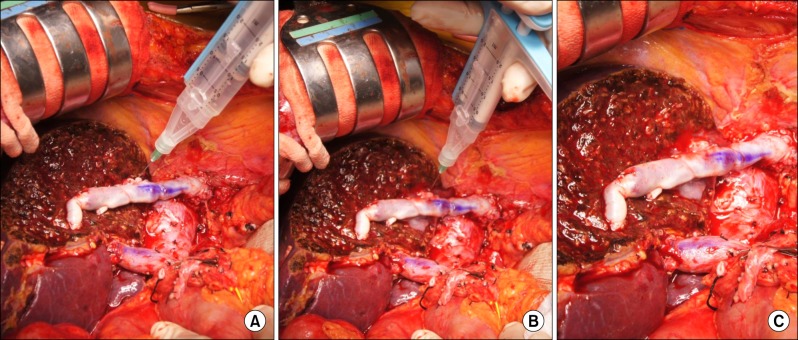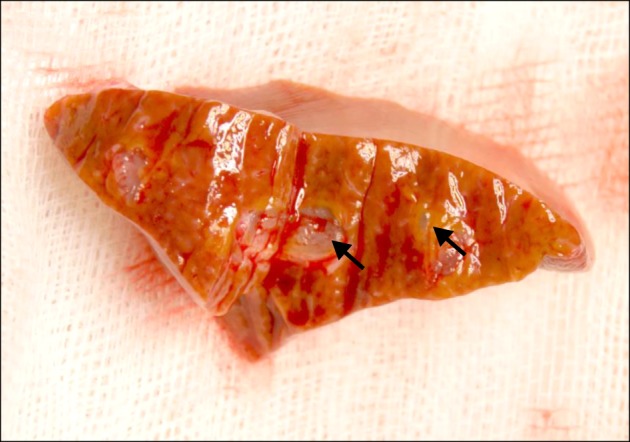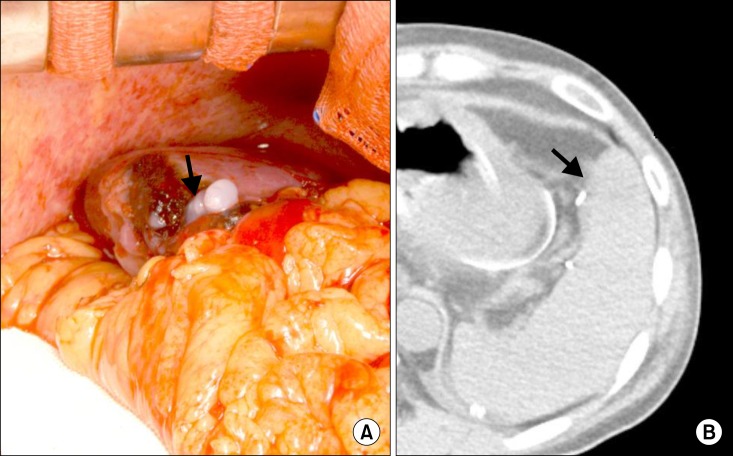Ann Hepatobiliary Pancreat Surg.
2016 Nov;20(4):197-200. 10.14701/ahbps.2016.20.4.197.
Fibrin glue-infiltrating hemostasis for intractable bleeding from the liver or spleen during liver transplantation
- Affiliations
-
- 1Division of Hepatobiliary Surgery and Liver Transplantation, Department of Surgery, Asan Medical Center, University of Ulsan College of Medicine, Seoul, Korea. shwang@amc.seoul.kr
- KMID: 2362471
- DOI: http://doi.org/10.14701/ahbps.2016.20.4.197
Abstract
- Portal hypertension induces congestion of the liver and spleen, thus any capsular or parenchymal injury to these organs can produce intractable bleeding which generally is not easily controlled. To cope with intractable bleeding such as being encountered during liver transplantation, we developed an infiltrating hemostasis technique as a conceptual shift from conventional application methods, in which fibrin glue is locally injected into the bleeding area on the liver or spleen. This technique, which uses a fibrin glue kit (2 ml kit; Greenplast, Green Cross, Seoul, Korea), consists of inserting the needle 0.5-1 cm deep at the bleeding point, forcefully injecting 1 ml of fibrin glue contained in the fibrin glue kit, and then slowly withdrawing the needle with continuous forceful injection of the remaining 1 ml of fibrin glue. We have successfully performed this procedure in 6 cases of living donor liver transplantation and in 2 cases of non-transplant resection of the cirrhotic livers with hepatocellular carcinoma. This technique was also successfully applied to one liver transplant recipient in which intractable bleeding occurred from a small laceration at the spleen. Our fibrin glue-infiltrating hemostasis would be indicated to intractable bleeding from the hepatic or splenic cut surface. In such a situation, it would be applicable as a second-line rescue method for hemostasis.
Keyword
MeSH Terms
Figure
Cited by 1 articles
-
Rescue fibrin glue-infiltrating hemostasis combined with hepatorrhaphy to control intractable postoperative bleeding from the liver cut surface
Shin Hwang, Byeong-Gon Na, Minjae Kim, Dae-Hyeon Won
Ann Hepatobiliary Pancreat Surg. 2021;25(4):517-522. doi: 10.14701/ahbps.2021.25.4.517.
Reference
-
1. Kirchner VA, Hwang S, Song GW, Ahn CS, Moon DB, Kim KH, et al. Resolution of hepatic venous congestion following gradual occlusion of middle hepatic vein interposition graft in living donor liver transplantation. Ann Transplant. 2016; 21:619–625. PMID: 27713391.
Article2. Hwang S, Lee SG, Park KM, Kim KH, Ahn CS, Lee YJ, et al. Hepatic venous congestion in living donor liver transplantation: preoperative quantitative prediction and follow-up using computed tomography. Liver Transpl. 2004; 10:763–770. PMID: 15162471.
Article3. Berrevoet F, de Hemptinne B. Use of topical hemostatic agents during liver resection. Dig Surg. 2007; 24:288–293. PMID: 17657154.
Article4. Mosesson MW. Fibrin polymerization and its regulatory role in hemostasis. J Lab Clin Med. 1990; 116:8–17. PMID: 2198321.
- Full Text Links
- Actions
-
Cited
- CITED
-
- Close
- Share
- Similar articles
-
- Rescue fibrin glue-infiltrating hemostasis combined with hepatorrhaphy to control intractable postoperative bleeding from the liver cut surface
- Comparison of Hemostatic Effect of Endoscopic Injection with Fibrin Glue (FG) and Hypertonic Saline - epinephrine (HSE) for Peptic Ulcer Bleeding: A prospective randomized trial
- Scleral Allografting and Amniotic Membrane Transplantation With Fibrin Glue in the Management of Scleromalacia
- The Efficiency of Fibrin Glue at Bicoronary Approach in Facial Surgery
- The Effect of Additional Factor XIII on Cross-linking in Fibrin Glue




